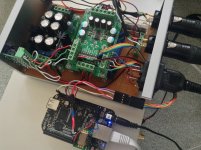If you use I2C control from the BBB to the Opus could make it happen. 🙂 The Opus (with WM8741) has I2C input for configuration. But this requires some work on the BBB side. 🙂
So no answer .....
Hi, I'm enjoying Opus Dac as well as BIII/BIIISE, either combined with BBB/Botic driver or with RasPi/Volumio. My Opus is partially controlled by I2C (Volumite for level control), so the setting of on-board switches may be different from what had been recommended so far.
But to make the conclusion short, I've confirmed the Opus with Botic BBB provided with external clock(s)* is able to handle up to 96K PCM sources including ripped ones from CDs (192K will be also possible but I didn't try it).
* 22.5792 or 45.1584 MHz in my case
The quality of playing PCM sources from Opus with Botic BBB is well comparable to the one from BIII/BIIISE but Opus can not handle DSD128, that could be some limitation with this WM8741 board.

-snip- (192K will be also possible but I didn't try it).
Well, I've confirmed that Opus with Botic BBB can also handle 192K source as indicated in the WM8741 manual (2-wire I2C software mode with DIFFHW=0, MODE/LRSEL=Z) and the result from /proc/asound/card0/pcm0p/sub0/ is shown below.
access: RW_INTERLEAVED
format: S24_3LE
subformat: STD
channels: 2
rate: 192000 (192000/1)
period_size: 1285
buffer_size: 21845
Thank you so much,will it auto detect all sample rates and lock to them? How about 44.1 KHz will it up sample ?
-snip- will it auto detect all sample rates and lock to them?
Yes, it does all. Below are the samples of different rates with Botic BBB:
access: RW_INTERLEAVED
format: S16_LE
subformat: STD
channels: 2
rate: 44100 (44100/1)
period_size: 2048
buffer_size: 32768
access: RW_INTERLEAVED
format: S24_3LE
subformat: STD
channels: 2
rate: 192000 (192000/1)
period_size: 1285
buffer_size: 21845
access: RW_INTERLEAVED
format: S24_3LE
subformat: STD
channels: 2
rate: 96000 (96000/1)
period_size: 1285
buffer_size: 21845
access: RW_INTERLEAVED
format: S16_LE
subformat: STD
channels: 2
rate: 48000 (48000/1)
period_size: 2048
buffer_size: 32768
BTW, the same 192K file on RasPi/Volumio can not be decoded correctly like below:
access: RW_INTERLEAVED
format: S24_LE
subformat: STD
channels: 2
rate: 44100 (44100/1)
period_size: 4410
buffer_size: 22050
IMFO, I think it will not do automatically and you'll have to prepare pre-upsampled fiels, if I'm correct.-snip- How about 44.1 KHz will it up sample ?
Just a FYI:Well, I've confirmed that Opus with Botic BBB can also handle 192K source as indicated in the WM8741 manual (2-wire I2C software mode with DIFFHW=0, MODE/LRSEL=Z) and the result from /proc/asound/card0/pcm0p/sub0/ is shown below.
access: RW_INTERLEAVED
format: S24_3LE
subformat: STD
channels: 2
rate: 192000 (192000/1)
period_size: 1285
buffer_size: 21845
The output of /proc/asound/<your card/pcm0p/sub0/hw_params is merely a reflection of how ALSA (the botic driver) is configured. If your DAC can cope is a whole other matter. The botic driver itself supports up to a rate of 768k.
Only a DAC with sw config support (e.g. via I2C) you can verify that a given rate is actually accepted.
Just a FYI:
The output of /proc/asound/<your card/pcm0p/sub0/hw_params is merely a reflection of how ALSA -snip-
Yeah, you are right. A shame for me to have forgotten to mention it. Thank you for this supportive comment.
Yes, that is remarkable but unfortunately is quite beyond the range of SR which Opus, only up to 192/176.4K, can be able to cope with. Anyway it could be said that such a higher resolution is one thing and the capability of I2S connection given to Opus by Botic BBB is another.The botic driver itself supports up to a rate of 768k.
This could be true and I found that adding Volumite to Opus is a quick and convenient solution to get I2C control, though not complete.Only a DAC with sw config support (e.g. via I2C) you can verify that a given rate is actually accepted.
And just because I know someone will ask: it also will work fine with COD. 🙂
And I might say: yes, it does well with COD (despite the reality of my COD board, having been delivered a few month ago, still not being soldered 😀).
Cronus thread here:
http://www.diyaudio.com/forums/twisted-pear/272007-cronus-its-about-time.html#post4271581
Available now. 🙂
http://www.diyaudio.com/forums/twisted-pear/272007-cronus-its-about-time.html#post4271581
Available now. 🙂
Cronus thread here:
http://www.diyaudio.com/forums/twisted-pear/272007-cronus-its-about-time.html#post4271581
Available now. 🙂
Congratulations Russ!
Here is the thread for the Hermes-BBB/Botic
http://www.diyaudio.com/forums/twis...-botic-cape-beaglebone-black.html#post4272641
http://www.diyaudio.com/forums/twis...-botic-cape-beaglebone-black.html#post4272641
Russ,
I've been following this thread to learn new things and now my question is what exactly are you intending to use these embedded devices for? What was the main purpose of this conglomeration of different sections of hardware and software? Just a noob when it comes to what you are doing here.
I've been following this thread to learn new things and now my question is what exactly are you intending to use these embedded devices for? What was the main purpose of this conglomeration of different sections of hardware and software? Just a noob when it comes to what you are doing here.
Russ,
I've been following this thread to learn new things and now my question is what exactly are you intending to use these embedded devices for? What was the main purpose of this conglomeration of different sections of hardware and software? Just a noob when it comes to what you are doing here.
My purpose is DIY fun! 🙂
It's a good question.
Personally one of my main aims was to create a smart reference level media renderer that can control my DAC as well as stream music to it. But it has evolved from there. You should track the hermes/cronus threads if you are interested.
- Home
- More Vendors...
- Twisted Pear
- Building an open embedded audio applicance.